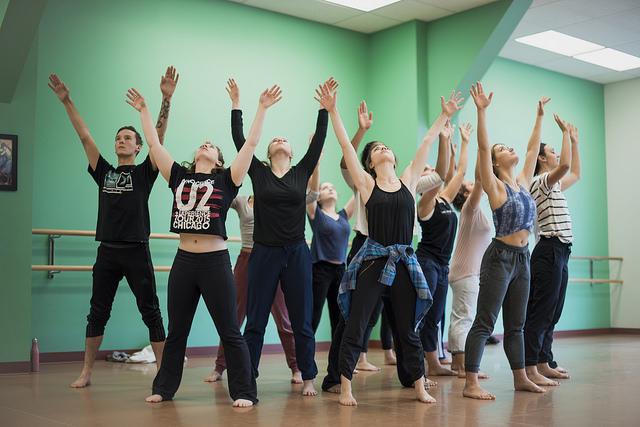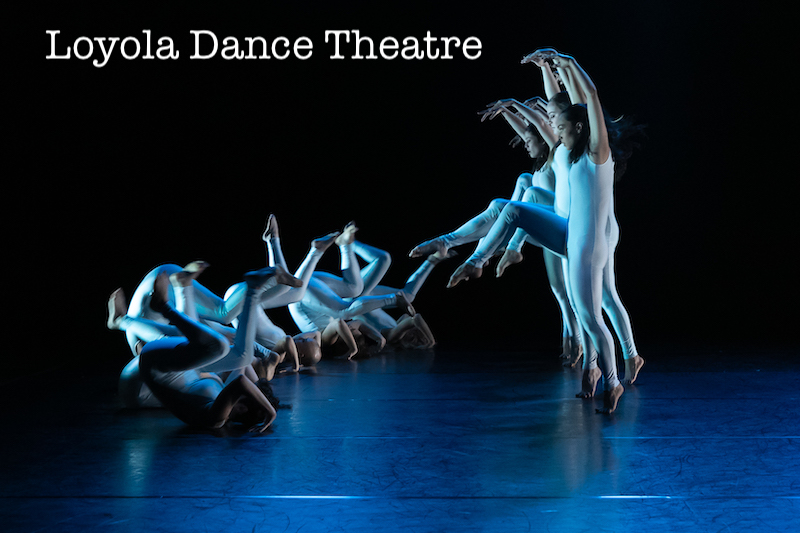By Jordan Kunkel
Loyola’s Dance program continues the celebration of its 10th anniversary this semester with a multifaceted artistic partnership and an interdisciplinary dance concert that highlight the innovation of the program’s faculty, students, and collaborators. 2017 Artist-in-Residence, Matthew Rose, from the Mark Morris Dance Group in New York City, culminates a semester of teaching classes and sharing his expert knowledge of dance music theory in a new creation to be featured in the annual dance concert, Voces Gratia, November 16-19.
Rose’s work, “Sing Me To Heaven,” brings literal voices of grace to the Newhart Theatre through a collaboration with choir director Steven Betancourt and Schola Cantorum, Loyola’s Liturgical Choir. The choir will perform live in the Newhart Family Theatre, accompanying the dancers for all four performances of Voces Gratia.
Rose’s piece, along with his residency at Loyola, has grown significantly since planning began two years ago. As a long-time friend of Sandra Kaufmann, Director of Loyola Dance, from back when they both lived in New York, the residency developed from Rose’s desire to leave New York City and Kaufmann’s need for a guest artist who could do more than set one dance piece.
The residency coincides with Kaufmann’s semester on sabbatical, which means along with choreographing for the annual dance concert, Rose is also teaching Dance majors and minors in Modern III and Ballet IV—classes that Kaufmann normally teaches. This semester, the classes focus on dance and music theory, a skill that Rose refined as Rehearsal Director for the Mark Morris Dance Group where he was constantly communicating with the live musicians who travel and perform with the company.
During his semester at Loyola, Rose hopes to impart deeper care for the musicality of movement onto the dance students at Loyola.
“Pedagogically the thing I see most is that people aren’t musically confident,” Rose said. “I want to also give [the dancers] the tools to not only be able to talk to an accompanist, but I think it’s useful to have if you’re choreographing as well, and if you decide to use music as part of the structure to the dance, that you can also express yourself in musical terms.”
This expertise in music expression led Kaufmann to propose that Rose work with Betancourt and the liturgical choir. Over the summer and throughout the semester, Betancourt and Rose developed the musical framework for the piece, eventually landing on four songs to carry the almost 15-minute dance.

For Rose, “Sing Me To Heaven” is in response to his daily habit of watching the news and to the anxiety that can come with the seeing the conflict in contemporary society every day.
“This work is something a bit deeper than these day-to-day concerns, even though they’re important. But they’re political, they’re not spiritual concerns, which I think sometimes is addressing the more existential questions of life,” Rose said. “Why are we here? What is the purpose of love? In a very abstract way, I’m hoping that this dance will be some sort of message for unity. People kind of need that right now.”
As for the themes behind the dance concert as a whole, Rose hopes that his piece will complement the other works in Voces Gratia:
“It’s interesting too, programmatically, that the whole evening is called that, and I’m lucky enough to have a choir—so that hammers that message home,” Rose said with a joking grin.
The other works in Voces Gratia confront themes of social justice as well as love and beauty. Senior Dance major, Maria Blanco, uses her voice to rally around the unapologetic woman in “Razor Burn” and brings movement, razors, and other elements to the stage to which any audience member can relate.
“Dance of the Blessed Spirits,” Isadora Duncan’s historical modern work from the early 20th century, uses movement in a unique restaging by Jennifer Sprowl to retell the trials and triumphs of the Greek character, Orfeo, and his challenging journey through the underworld.
Other pieces include “Reba” by Amy Wilkinson, Artistic Director of the dance concert—which first premiered in Rome over the summer—and two classical ballet excerpts which feature duet partnering and skilled corps de ballet work.
Following Voces Gratia, Rose will have a few weeks to close out his semester with the dance students before heading back to his current home in Santa Fe, New Mexico. As he enters a new phase in his career post New York and post Mark Morris Dance Group, Rose wants to explore Albuquerque’s growing film scene. He hopes to put his Rehearsal Director experience to use as a Production Assistant behind-the-scenes.
“It’s interesting because I’m at the end of my career and you all are at the beginning of yours, and I think that this department gives people a really good foundation from which to spring if you want to go professionally, if you want to go pedagogically, if you want to do something else,” Rose said. “The vibe here [at Loyola] is fantastic and very supportive, and that’s not always true in dance.”
Want to see “Sing Me To Heaven” and the rest of Voces Gratia on stage? Visit the ticketing website: artsevents.luc.edu/dance
Featured Photo: Emma Petersen

